Mathematical Modeling of Groundwater Flow: A Case Study of Foundation Piles in the Vicinity of Danube River
Abstract
:1. Introduction
2. Materials and Methods
2.1. Study Area
2.2. Methodology
2.3. Conceptual Model
2.4. Model Calibration
3. Results and Discussion
4. Conclusions
Author Contributions
Funding
Institutional Review Board Statement
Informed Consent Statement
Data Availability Statement
Conflicts of Interest
References
- Jisun, K.; Sung-Wook, J.; Hyoun Soo, L.; Jeonghoon, L.; Ok-Sun, K.; Hyoungseok, L.; Soon Gyu, H. Hydrogeological characteristics of groundwater and surface water associated with two small lake systems on King George Island, Antarctica. J. Hydrol. 2020, 590. [Google Scholar] [CrossRef]
- Baki, S.; Hilali, M.; Kacimi, I.; Kassou, N.; Nouayti, N.; Bahassi, A. Assessment of groundwater intrinsic vulnerability to pollution in the Pre-Saharan areas—The case of the Tafilalet plain (Southeast Morocco). Procedia Earth Planet. Sci. 2017, 17, 590–593. [Google Scholar] [CrossRef]
- Xu, X.; Huang, G.; Qu, Z.; Pereira, L. Using MODFLOW and GIS to assess changes in groundwater dynamics in response to water saving measures in irrigation districts of the upper Yellow River basin. Water Resour. Manag. 2011, 25, 2035–2059. [Google Scholar] [CrossRef]
- Carreira, P.M.; Bahir, M.; Ouhamdouch, S.; Fernandes, P.G.; Nunes, D. Tracing salinization processes in coastal aquifers using an isotopic and geochemical approach: Comparative studies in western Morocco and southwest Portugal. Hydrogeol. J. 2018, 26, 2595–2615. [Google Scholar] [CrossRef]
- Moghaddam, H.K.; Moghaddam, H.K.; Kivi, Z.R.; Bahreinimotlagh, M.; Alizadeh, M.J. Developing comparative mathematic models, BN and ANN for forecasting of groundwater levels. Groundw. Sustain. Dev. 2019, 9, 100237. [Google Scholar] [CrossRef]
- Leake, S.A.; Hoffmann, J.P.; Dickinson, J.E. Numerical ground-water change model of the C aquifer and effects of ground-water withdrawals on stream depletion in selected reaches of Clear Creek, Chevelon Creek, and the Little Colorado River, northeastern Arizona. U.S. Geol. Surv. Sci. Investig. Rep. 2005, 5277. [Google Scholar] [CrossRef]
- Mengistu, H.; Tessema, A.; Abiye, T.; Demlie, M.; Lin, H. Numerical modeling and environmental isotope methods in integrated mine-water management: A case study from the Witwatersrand basin, South Africa. Hydrogeol. J. 2015, 23, 533–550. [Google Scholar] [CrossRef]
- Yihdego, Y.; Danis, C.; Paffard, A. 3-D numerical groundwater flow simulation for geological discontinuities in the Unkheltseg Basin, Mongolia. Environ. Earth Sci. 2015, 73, 4119–4133. [Google Scholar] [CrossRef]
- Yihdego, Y.; Webb, A.J.; Leahy, P. Modelling of lake level under climate change conditions: Lake Purrumbete in southeastern Australia. Environ. Earth Sci. 2015, 73, 3855–3872. [Google Scholar] [CrossRef]
- Yidana, S.M.; Essel, S.K.; Addai, M.O.; Fynn, O.F. A preliminary analysis of the hydrogeological conditions and groundwater flow in some parts of a crystalline aquifer system: Afigya Sekyere South District, Ghana. J. Afr. Earth Sci. 2015, 104, 132–139. [Google Scholar] [CrossRef]
- Mengistu, H.A.; Demlie, M.B.; Abiye, T.A.; Xu, Y.; Kanyerere, T. Conceptual hydrogeological and numerical groundwater flow modelling around the Moab Khutsong deep gold mine, South Africa. Groundw. Sustain. Dev. 2019, 9, 100266. [Google Scholar] [CrossRef]
- Malekzadeh, M.; Kardar, S.; Shabanlou, S. Simulation of groundwater level using MODFLOW, extreme learning machine and Wavelet-Extreme Learning Machine models. Groundw. Sustain. Dev. 2019, 9, 100279. [Google Scholar] [CrossRef]
- Fioreze, M.; Mancuso, A.M. MODFLOW and MODPATH for hydrodynamic simulation of porous media in horizontal subsurface flow constructed wetlands: A tool for design criteria. Ecol. Eng. 2019, 130, 45–52. [Google Scholar] [CrossRef]
- Almuhaylan, M.R.; Ghumman, A.R.; Al-Salamah, I.S.; Ahmad, A.; Ghazaw, Y.M.; Haider, H.; Shafiquzzaman, M. Evaluating the Impacts of Pumping on Aquifer Depletion in Arid Regions Using MODFLOW, ANFIS and ANN. Water 2020, 12, 2297. [Google Scholar] [CrossRef]
- Chakraborty, S.; Maity, K.P.; Das, S. Investigation, simulation, identification and prediction of groundwater levels in coastal areas of Purba Midnapur, India, using MODFLOW. Environ. Dev. Sustain. 2020, 22, 3805–3837. [Google Scholar] [CrossRef]
- La Licata, I.; Colombo, L.; Francani, V.; Alberti, L. Hydrogeological Study of the Glacial—Fluvioglacial Territory of Grandate (Como, Italy) and Stochastical Modeling of Groundwater Rising. Appl. Sci. 2018, 8, 1456. [Google Scholar] [CrossRef]
- Qiu, S.; Liang, X.; Xiao, C.; Huang, H.; Fang, Z.; Lv, F. Numerical Simulation of Groundwater Flow in a River Valley Basin in Jilin Urban Area, China. Water 2015, 7, 5768–5787. [Google Scholar] [CrossRef]
- Aghlmand, R.; Abbasi, A. Application of MODFLOW with Boundary Conditions Analyses Based on Limited Available Observations: A Case Study of Birjand Plain in East Iran. Water 2019, 11, 1904. [Google Scholar] [CrossRef]
- Wondzell, M.S.; LaNier, J.; Haggerty, R. Evaluation of alternative groundwater flow models for simulating hyporheic exchange in a small mountain stream. J. Hydrol. 2009, 364, 142–151. [Google Scholar] [CrossRef]
- Li, F.; Liu, Y.; Zhao, Y.; Deng, X.; Jiang, R. Regulation of shallow groundwater based on MODFLOW. Appl. Geogr. 2019, 110, 102049. [Google Scholar] [CrossRef]
- Phoban, H.; Seeboonruang, U.; Lueprasert, P. Numerical Modeling of Single Pile Behaviors Due to Groundwater Level Rising. Appl. Sci. 2021, 11, 5782. [Google Scholar] [CrossRef]
- Phoban, H.; Seeboonruang, U.; Lueprasert, P. Numerical investigation on pile behavior due to the rising groundwater effect. Int. J. Geomat. 2021, 20, 171–176. [Google Scholar] [CrossRef]
- Yuan, B.; Li, Z.; Chen, W.; Zhao, J.; Lv, J.; Song, J.; Cao, X. Influence of Groundwater Depth on Pile–Soil Mechanical Properties and Fractal Characteristics under Cyclic Loading. Fractal Fract. 2022, 6, 198. [Google Scholar] [CrossRef]
- Budinski, L.; Fabian, J.; Stipić, M. Lattice Boltzmann method for groundwater flow in non-orthogonal structured lattices. Comput. Math. Appl. 2015, 70, 2601–2615. [Google Scholar] [CrossRef]
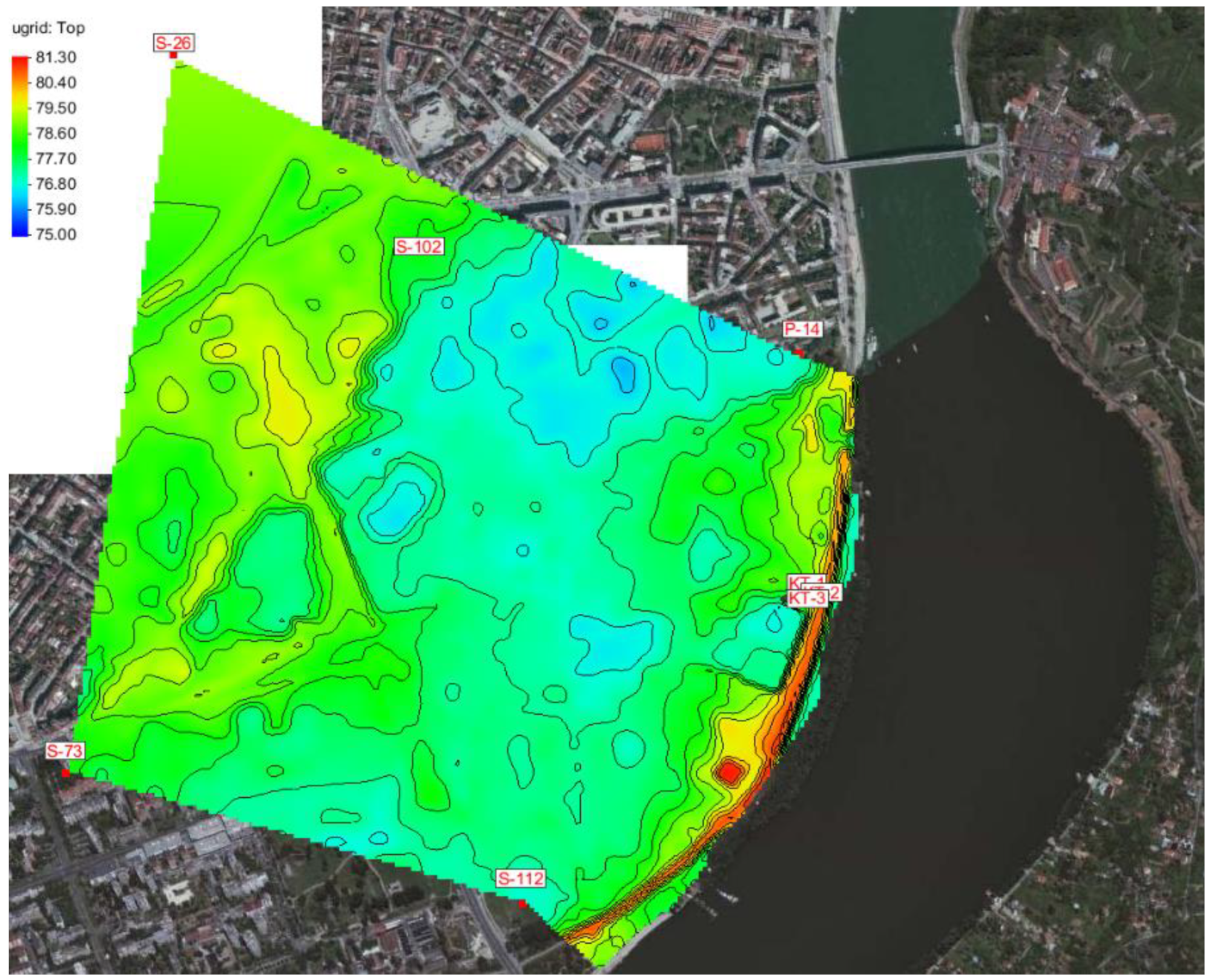
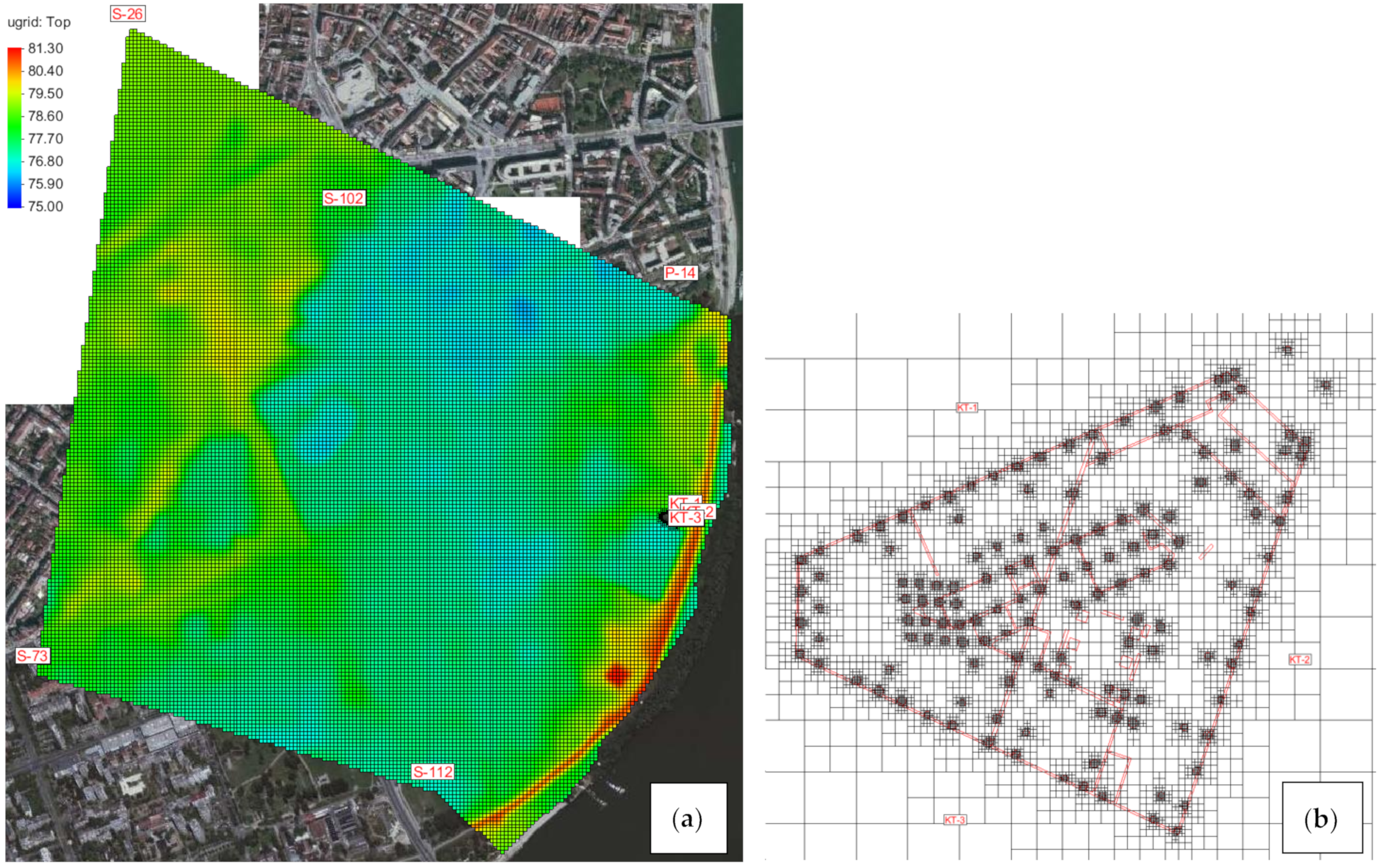

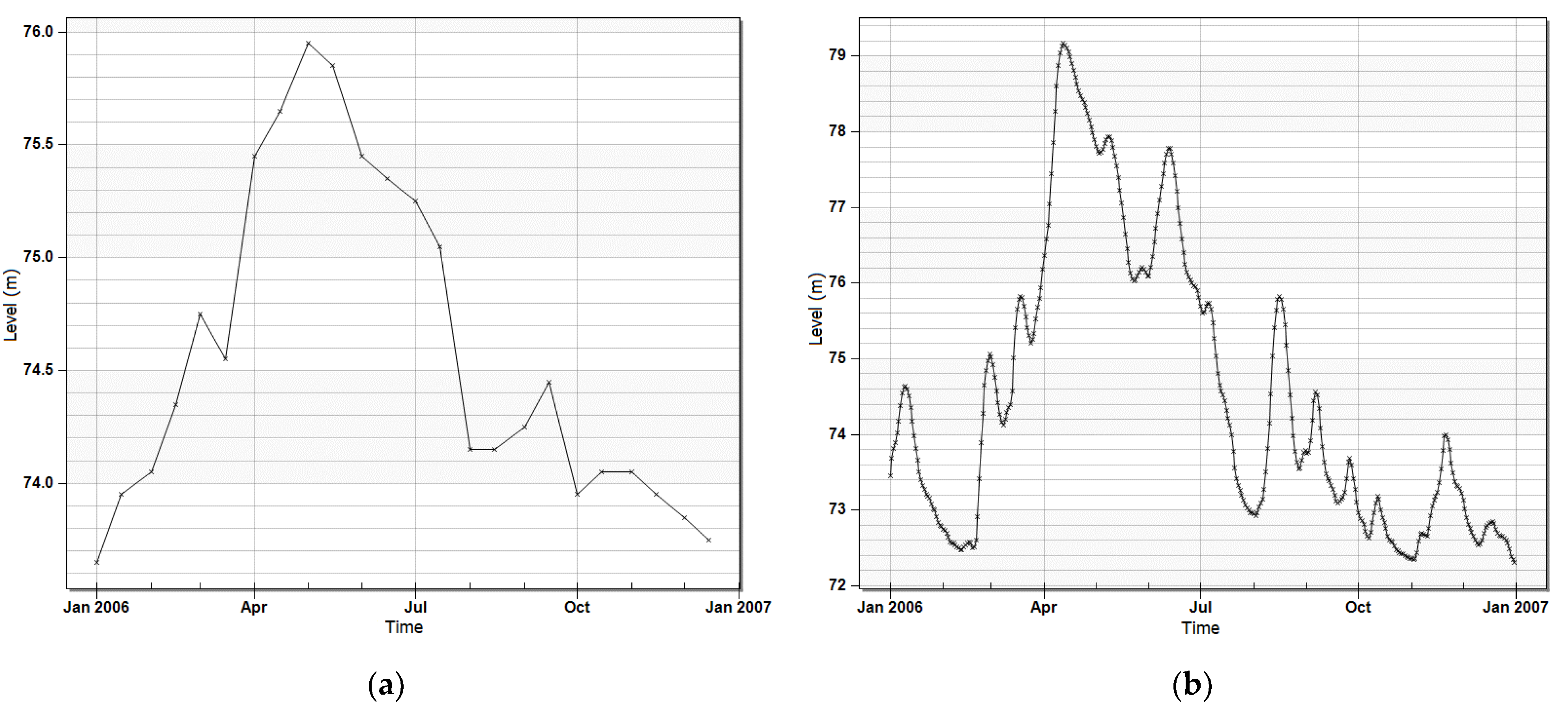
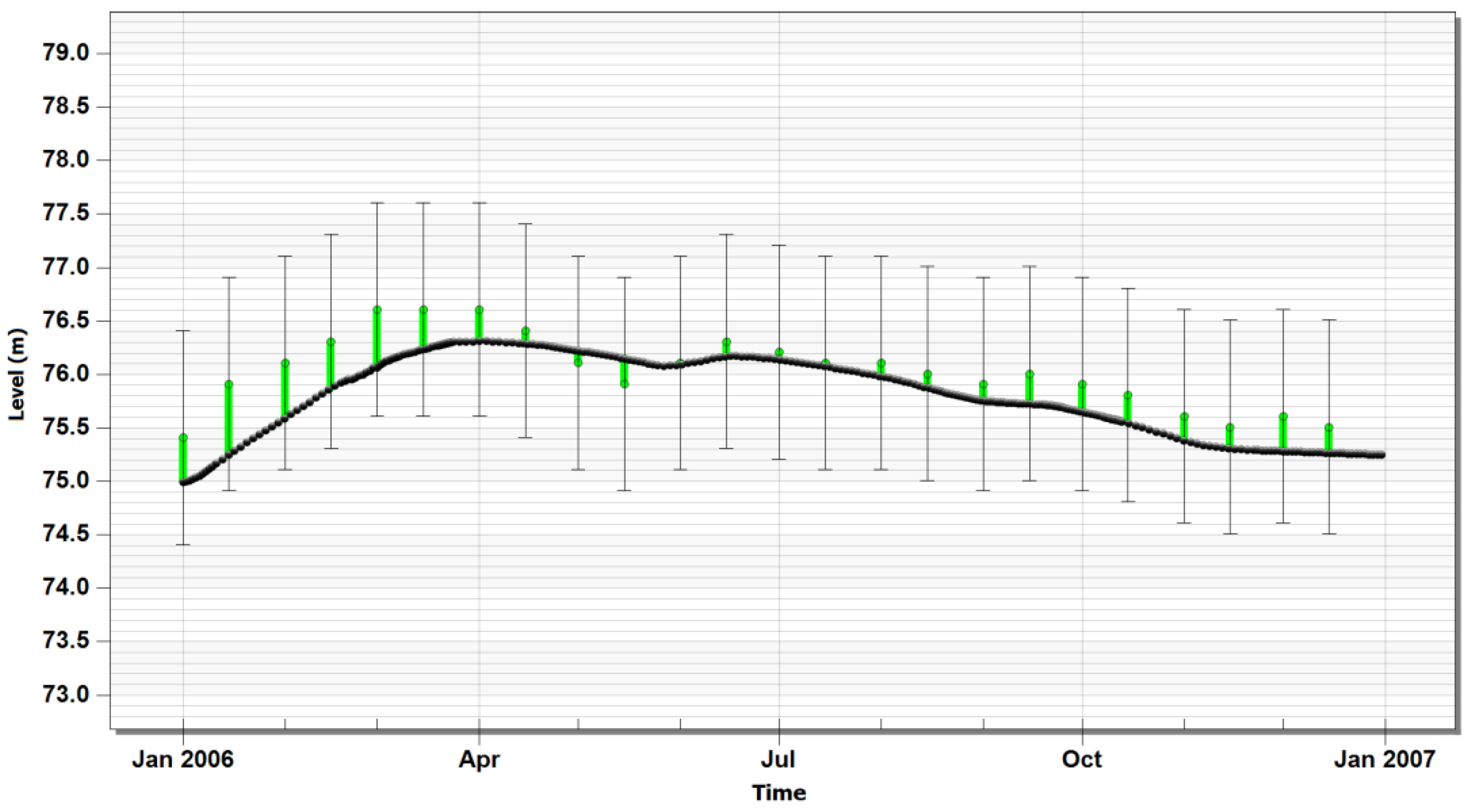
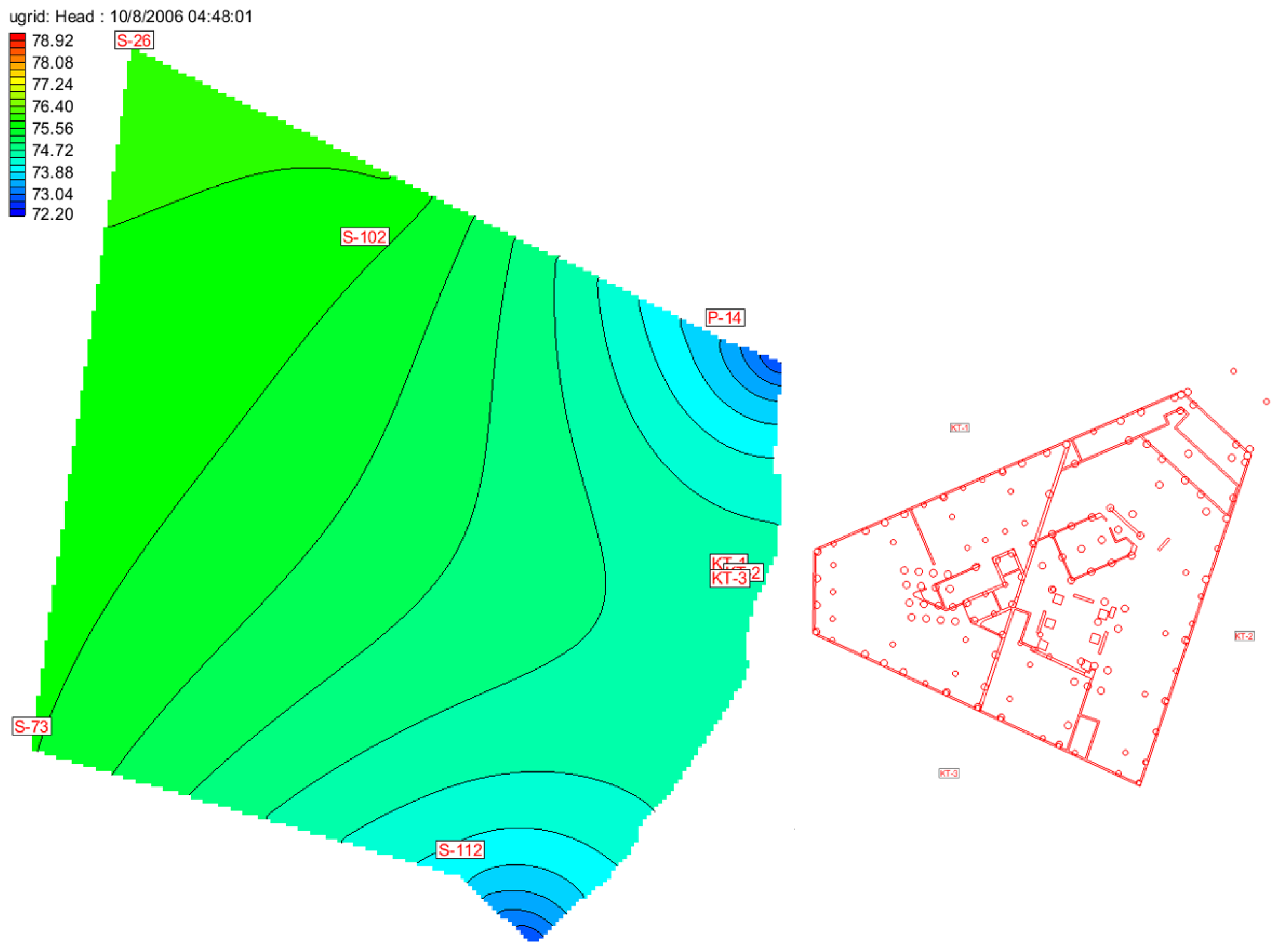
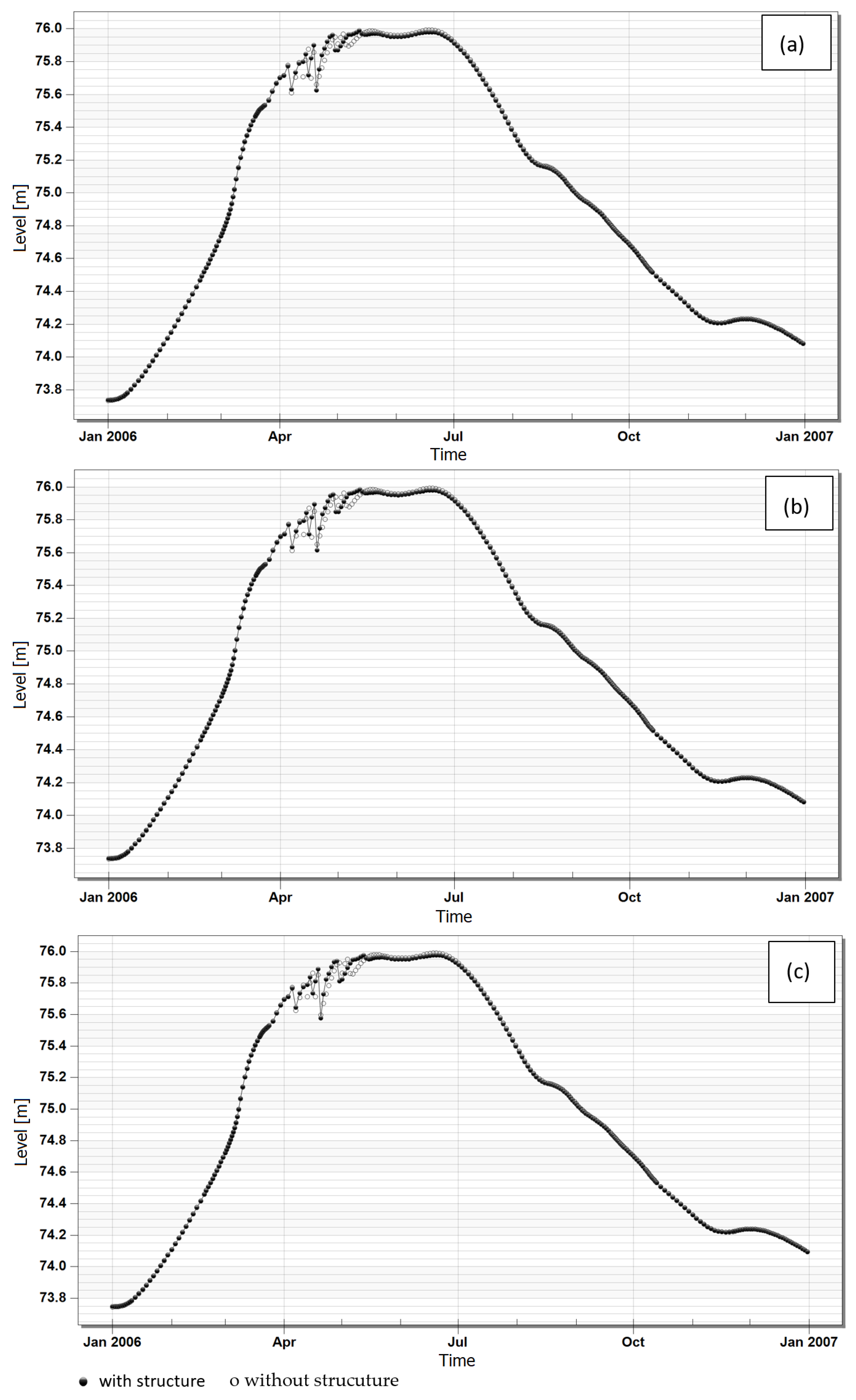
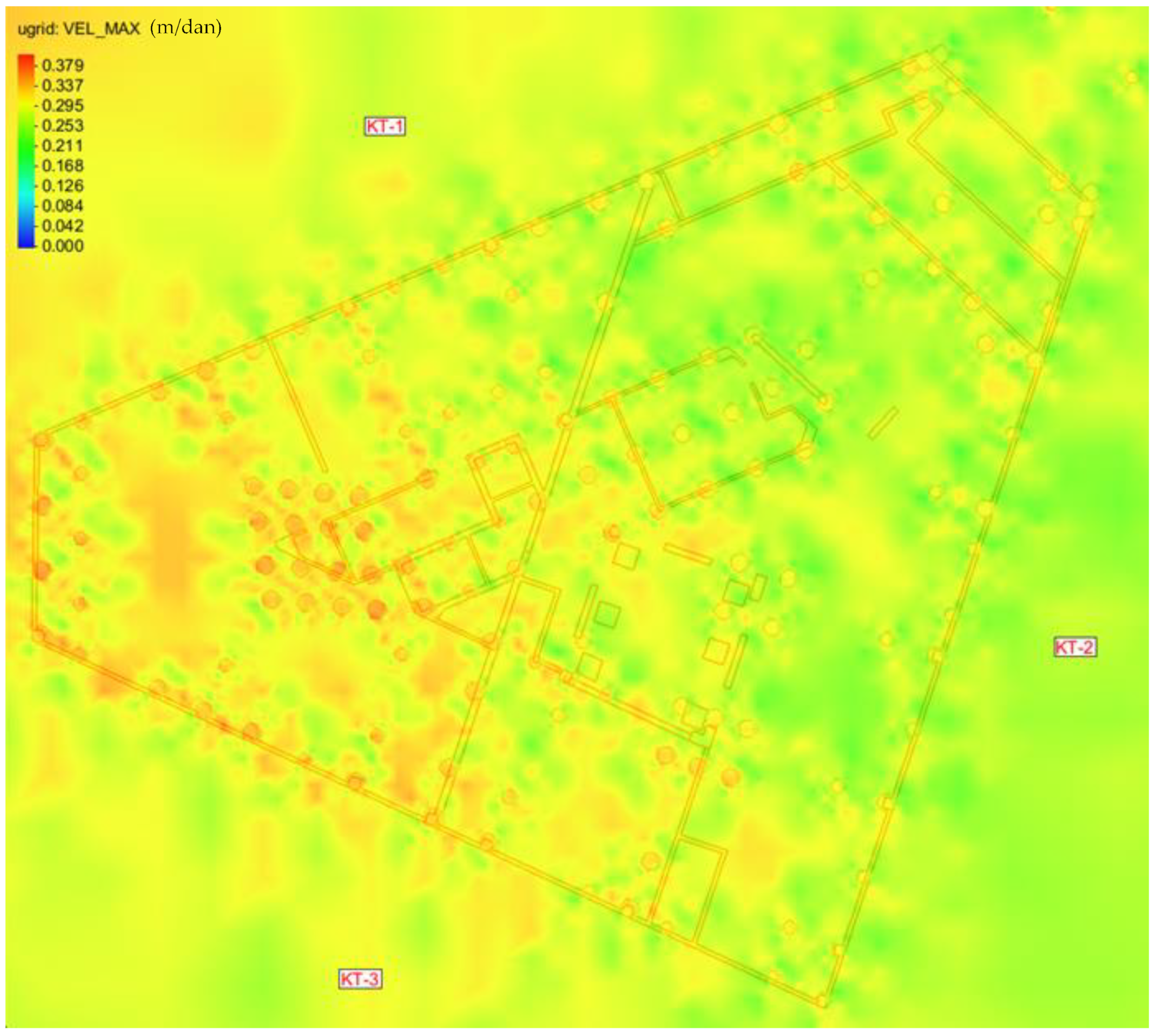

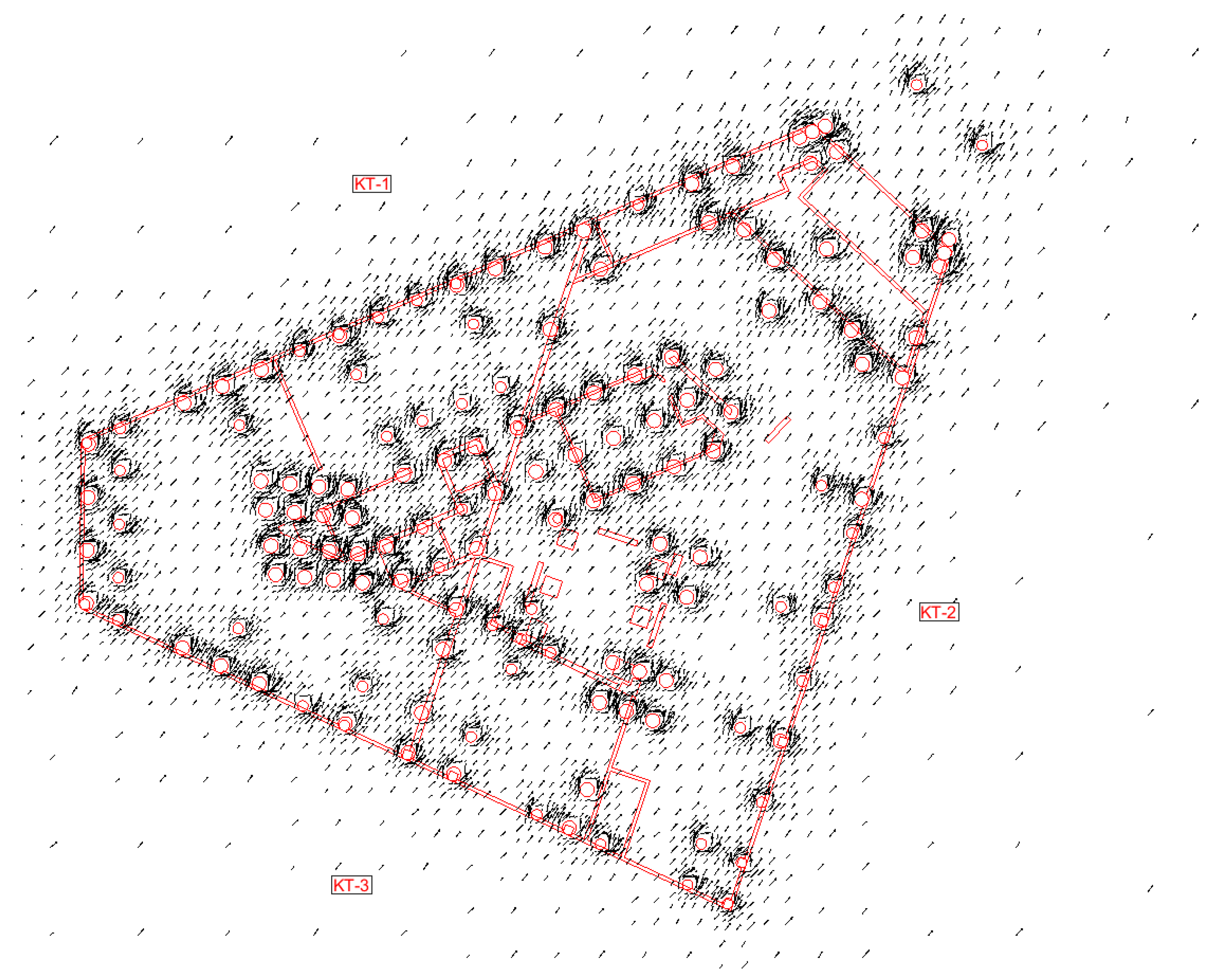
Disclaimer/Publisher’s Note: The statements, opinions and data contained in all publications are solely those of the individual author(s) and contributor(s) and not of MDPI and/or the editor(s). MDPI and/or the editor(s) disclaim responsibility for any injury to people or property resulting from any ideas, methods, instructions or products referred to in the content. |
© 2023 by the authors. Licensee MDPI, Basel, Switzerland. This article is an open access article distributed under the terms and conditions of the Creative Commons Attribution (CC BY) license (https://creativecommons.org/licenses/by/4.0/).
Share and Cite
Milić, M.; Jeftenić, G.; Stipić, D.; Budinski, L. Mathematical Modeling of Groundwater Flow: A Case Study of Foundation Piles in the Vicinity of Danube River. Appl. Sci. 2023, 13, 13277. https://doi.org/10.3390/app132413277
Milić M, Jeftenić G, Stipić D, Budinski L. Mathematical Modeling of Groundwater Flow: A Case Study of Foundation Piles in the Vicinity of Danube River. Applied Sciences. 2023; 13(24):13277. https://doi.org/10.3390/app132413277
Chicago/Turabian StyleMilić, Marijana, Goran Jeftenić, Danilo Stipić, and Ljubomir Budinski. 2023. "Mathematical Modeling of Groundwater Flow: A Case Study of Foundation Piles in the Vicinity of Danube River" Applied Sciences 13, no. 24: 13277. https://doi.org/10.3390/app132413277




